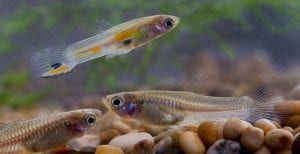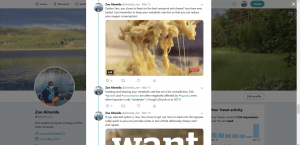Latent effects are responses to conditions or events in an early developmental period that appear later in that individual’s life. Latent effects can set individuals on lifelong trajectories (e.g., high quality food in early life allows for more resilience throughout life, Adler et al., 2013), can allow individuals to be better able to utilize resources later in life (e.g., exposure to stressors in early life causes individuals to have more adaptive responses to stressors as adults, Wang et al., 2016), and alter life history tradeoffs (e.g., individuals who grow and reach maturity quickly die young, Bronikowski and Arnold, 1999). They can be considered a type of carry-over effect (O’Connor et al., 2014), and, similarly, latent effects are likely important for conservation and management strategies (O’Connor and Cooke, 2015).

This early life experience of pretending to be a banana is unlikely to cause a latent effect for this kitten. However, if adorable young animals becoming bananas becomes an alternate life history, physiologists need to study how this can happen and conservation science needs to explore the potential consequences for populations.
Photo from: https://pics.me.me/
When examined individually, latent effects can be thought of as causing two different responses: 1) latent effects make individuals stronger and more adaptive, and 2) latent effects establish an individual’s fate. Latent effects that make individuals stronger and more adaptive can be observed in studies that demonstrate how individuals with poor beginnings can better take advantage of resources once they become available. For example, guppies fed reduced amounts of food during their juvenile stage were able to increase their growth rates once food availability increased, eventually reaching a similar size of individuals that were not fed a restricted diet as juveniles (Auer et al., 2010).

Guppies demonstrated latent effects as compensatory growth during recovery from food deprivation. Photo from: https://wikimedia.org/wikipedia/commons
And, adult zebra finches that were exposed to poor nutrition in early life were able to learn patterns of where food was located more quickly compared with zebra finches that were well-fed in early life (Brust et al., 2014).

Zebra finch with poor quality food in early life (LQT) demonstrated a latent effect with their ability to learn patterns more quickly than individuals with high quality food (HQT). Figure modified from Brust et al. (2014) Fig. 3 and https://farm8.staticflickr.com
Latent effects establishing an individual’s fate can be observed in species that demonstrate a “silver spoon” effect, where the conditions in early life provide some individuals with a jump start and others with baggage. For example, python growth rates throughout life were correlated with their growth rate during the first year of life (Madsen and Shine, 2000). This was explained because prey variability differed across years, and pythons born in years with high prey availability had faster than average growth rates. Ultimately, fast growers in early life were always fast growers.

Pythons that grew fast in their first year of life had higher growth rates throughout their life.
Figure adapted from Madsen and Shine (2000) Fig. 3 and https://encrypted-tbn0.gstatic.com
Alternatively, a bad start can perpetuate difficulties throughout life. Pikeperch that were deprived of essential fatty acids during their larval period had a lower tolerance of stress caused by salinity later in life (Lund et al., 2012). Individuals may experience both the beneficial and the detrimental consequences of their early life experience throughout their life. Cumulatively, the latent responses an individual has adds layers of variation that may cause two individuals of the same species that live in similar environments to have surprisingly different lives (e.g., Xie et al., 2015).
This fascinating aspect of natural variation between individuals is well documented across a range of vertebrate and invertebrate species (Lindström, 1999; Pechenik, 2006); however, latent effects are rarely considered in questions about population or community responses to large-scale environmental changes. A major reason for this is that it can be difficult to track individuals throughout their entire life and take complicated measurements like body condition and number of offspring that survive to reproduce. Studies that examine cohort-level effects can address aspects of latent effects if they incorporate environmental conditions in the early life environment into predictions about current responses (Beckerman et al., 2003).
Understanding the influence of latent effects on individual, cohort, and population responses is becoming more important to conservation physiology as management and conservation of rare species may rely on being able to predict variation in responses to environmental change. Large-scale environmental changes affect individuals directly in the short-term in numerous ways (e.g., see the topics discussed on the blog for this class such as how microplastics may cause endocrine disruption in sea birds, how the warming of global temperatures may disrupt sex determination and reptile populations, etc.). However, the long-term consequences of these environmental changes may have surprising effects on populations if we do not consider latent responses of environmental change on individuals in early life.
References
Adler MI, Cassidy EJ, Fricke C, Bonduriansky R (2013) The lifespan-reproduction trade-off under dietary restriction is sex-specific and context-dependent. Exp Gerontol 48: 539–548.
Auer SK, Arendt JD, Chandramouli R, Reznick DN (2010) Juvenile compensatory growth has negative consequences for reproduction in Trinidadian guppies (Poecilia reticulata). Ecol Lett 13: 998–1007.
Beckerman AP, Benton TG, Lapsley CT, Koesters N (2003) Talkin’ ’bout my generation: Environmental variability and cohort effects. Am Nat 162: 754–767.
Bronikowski AM, Arnold SJ (1999) The evolutionary ecology of life history variation in the garter snake Thamnophis elegans. Ecology 80: 2314–2325.
Brust V, Krüger O, Naguib M, Krause ET (2014) Lifelong consequences of early nutritional conditions on learning performance in zebra finches (Taeniopygia guttata). Behav Processes 103: 320–326.
Lindström J (1999) Early development and fitness in birds and mammals. Trends Ecol Evol 14: 343–348.
Lund I, Skov PV, Hansen BW (2012) Dietary supplementation of essential fatty acids in larval pikeperch (Sander lucioperca); short and long term effects on stress tolerance and metabolic physiology. Comp Biochem Physiol – A Mol Integr Physiol 162: 340–348.
Madsen T, Shine R (2000) Silver spoons and snake body sizes: Prey availability early in life influences long-term growth rates of free-ranging pythons. J Anim Ecol 69: 952–958.
O’Connor CM, Cooke SJ (2015) Ecological carryover effects complicate conservation. Ambio 44: 582–591.
O’Connor CM, Norris DR, Crossin GT, Cooke SJ (2014) Biological carryover effects: Linking common concepts and mechanisms in ecology and evolution. Ecosphere 5: 1–11.
Pechenik JA (2006) Larval experience and latent effects – Metamorphosis is not a new beginning. Integr Comp Biol 46: 323–333.
Wang Y, Campbell JB, Kaftanoglu O, Page RE, Amdam G V., Harrison JF (2016) Larval starvation improves metabolic response to adult starvation in honey bees (Apis mellifera L.). J Exp Biol 219: 960–968.
Xie J, De Clercq P, Pan C, Li H, Zhang Y, Pang H (2015) Larval nutrition-induced plasticity affects reproduction and gene expression of the ladybeetle, Cryptolaemus montrouzieri. BMC Evol Biol 15. doi:10.1186/s12862-015-0549-0
















